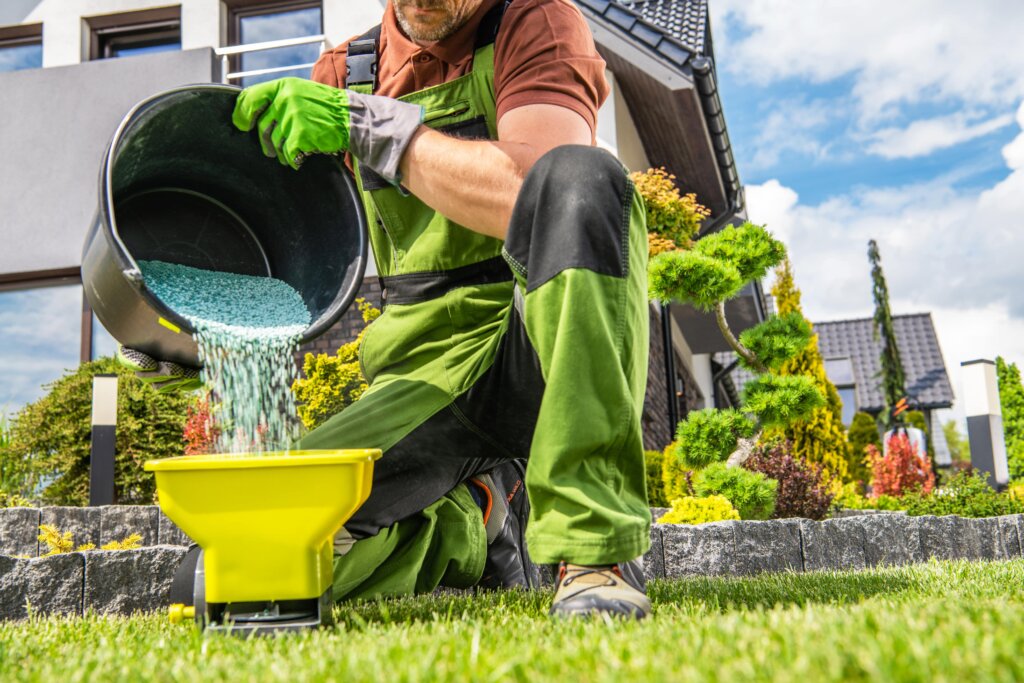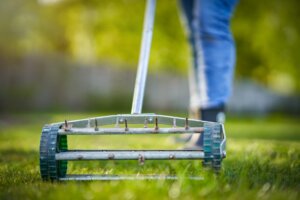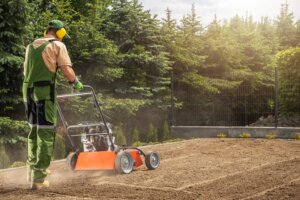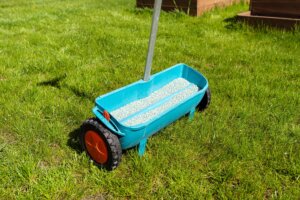A well-timed lawn fertilizer schedule is the key to maintaining a lush, green lawn in Pennsylvania. Proper fertilizer timing ensures your grass grows strong, resists weeds, survives heat and drought, and stores enough energy for winter. For insights on the best time to fertilize, see our seasonal timing guide.
Key Takeaways
- Fertilize cool-season grasses (bluegrass, fescue, ryegrass) in early spring, early summer, early fall, and late fall.
- Test the soil yearly to balance nutrients and pH.
- Apply 3–4 lbs of nitrogen per 1,000 sq ft per year in split feedings.
- Skip during heat or drought to prevent stress.
- Choose organic or pet-safe fertilizers for healthier growth.
- Adjust your schedule based on rainfall, soil temperature, and growth patterns.
For localized advice tailored to your region, explore Terra Lawn Care’s service areas across Pennsylvania and the Tri-State region to see how their experts can help keep your lawn healthy year-round.
Understanding Your Lawn’s Needs
Cool-Season Grasses in Pennsylvania
Pennsylvania lawns thrive on cool-season grasses like Kentucky Bluegrass, Fine Fescue, Tall Fescue, and Perennial Ryegrass. These grass types prefer cooler weather and may slow or go semi-dormant during the summer months.
If you live farther south, warm-season grasses, like Bermuda or St. Augustine, require different timing suited to southern lawns. For local expertise and year-round lawn fertilization programs designed for Pennsylvania’s climate, Terra Lawn Care offers custom solutions backed by over 50 years of agronomy experience.
Did you know that Pennsylvania homeowners maintain over 2 million acres of turfgrass, representing about 70 % of the state’s residential green space? If even a fraction of those lawns followed a lawn fertilizer schedule optimized for cool-season grasses, we’d see healthier landscapes and much less nutrient runoff.
Soil Testing and Fertilizer Application Basics
Before fertilizing your lawn, start with a soil test. It reveals nutrient gaps, pH balance, and the best fertilizer bag formulation for your yard. Adjust fertilizer application rates based on results and local fertilizer blackout dates to prevent runoff.
For the best results, feed during active growth periods, not just by the calendar, to maintain a greener lawn all year. Check our guide on when to apply lawn fertilizer for seasonal insights.
Month-by-Month Lawn Fertilizer Schedule (Pennsylvania)

January–February (Winter Planning)
Lawns are dormant. Use this downtime for lawn care tasks like soil testing and planning. Avoid fertilizer application on frozen soil or during fertilizer blackout dates.
March (Early Spring – Best Time to Start)
As soil temperatures reach 50°F, it’s the best time for fertilizing your lawn. Apply pre-emergent fertilizer to control weeds such as crabgrass. Water lightly after application. For more tips on spring fertilizing, check when and how to feed your grass for strong root growth without overstimulation.
April (Spring Growth Boost)
By early April, apply a balanced fertilizer to promote steady plant and root growth. Spot-treat dandelions or broadleaf weeds with an herbicide if needed. Keep soil moist but not soggy.
May (Late Spring Feeding)
During late spring, apply a light, nitrogen-rich mix to maintain color and density. In mid-May, reduce rates if the heat rises to prevent stress and burning.
June (Early Summer Fertilizing)
Use a slow-release fertilizer to strengthen deep roots before heat and drought arrive. Apply in the morning or evening and water in gently for proper nutrient absorption.
Unsure how to protect your turf through rising temperatures? Explore our summer fertilizing guide for warm, humid months in Pennsylvania.
July–August (Mid to Late Summer Adjustment)
Cool-season lawns often rest in hot summer months. Skip feeding unless a soil test shows deficiencies. Prioritize watering and higher mowing for most lawns to reduce stress.
September (Early Fall Recovery)
Early fall is prime for fertilizing your lawn. Apply 1 lb of nitrogen per 1,000 sq ft to restore color and density after summer. This helps root growth and prepares for cooler weather. Learn the full timing and techniques in our expert guide to fall fertilizing for Pennsylvania’s cool-season grasses.
October (Late Fall Winterizer)
Late October is your last feeding. Not sure what fertilizer to use in fall? Choose a high-nitrogen mix like 24-0-10 designed for cool-season turf to prepare your lawn for winter dormancy.
November–December (Winter Dormancy)
By early November, stop fertilizing. Focus on lawn care tasks: raking, clearing debris, and checking drainage. Fertilizer applied now won’t benefit growth and may wash away.
Fertilizer Timing by Season (PA Cool-Season Turf)
Here’s a quick seasonal guide to keep Pennsylvania’s cool-season turf healthy and greener year-round.
| Season | Timing Window | Purpose & Fertilizer Tips |
|---|---|---|
| Early Spring | March–April | Jumpstart growth after cold dormancy. Apply 0.5–1 lb N/1,000 sq ft slow-release fertilizer with crabgrass and weed control when soil temperatures warm. |
| Early Summer | Late May–June | Strengthen deep roots before the heat. Use a slow-release mix and follow this summer lawn fertilizer guide to adjust feeding during drought or heat stress. |
| Early Fall | September | Repair summer damage and boost root growth. Follow fall lawn fertilizer best practices to apply 1 lb N/1,000 sq ft balanced fertilizer for recovery and root development. |
| Late Fall (Winterizer) | Late Oct–Early Nov | Store energy before dormancy. Apply 1 lb N/1,000 sq ft high-nitrogen fertilizer for a greener lawn next spring. |
Regular fertilizer application matched to grass type and temperature keeps most lawns thriving.
Fertilizer Types and Application Rates

- Nitrogen (N): Promotes color and growth
- Phosphorus (P): Aids root development
- Potassium (K): Improves drought and disease resistance
Most Pennsylvania lawns perform best with 1 lb of nitrogen per 1,000 sq ft per feeding, adjusted according to soil test results. For fall applications, understanding what fertilizer to use in fall can make a big difference, especially when preparing your cool-season grass for winter dormancy and ensuring a greener comeback in spring.
Choose pet-safe or organic fertilizers like composted manure, alfalfa meal, or corn gluten meal whenever possible.
Application and Care Tips
Follow these simple lawn care and fertilizer application guidelines to keep your cool-season turf healthy and vibrant throughout Pennsylvania’s growing season.
| Category | Frequency / Timing | Quick Tips |
|---|---|---|
| Soil Testing | Every 2–3 years | Check pH and nutrients; most PA lawns need lime to balance acidity and support a greener lawn. |
| Fertilizer Rates | 3–4 lbs N per 1,000 sq ft annually | Split into 3–4 feedings for cool-season grasses to promote steady root growth. |
| Watering | Within 24 hours of feeding | Water in fertilizer unless rain is expected; skip fertilizer application before storms. |
| Drought & Heat | During heat and drought periods | Pause fertilizing when soil temperatures exceed 75°F; resume once cooler. |
| Mowing & Maintenance | Weekly during growth | Keep blades sharp, mow high, control weeds, and aerate once a year for stronger turf. |
Consistent care through proper feeding, watering, and mowing ensures a greener lawn that withstands Pennsylvania’s shifting weather. If you need help maintaining a greener lawn, contact our certified turf specialists at Terra Lawn Care for a customized lawn fertilization plan.
How Often to Fertilize
Wondering how often to fertilize? Most PA lawns perform best with 3–4 feedings spaced 6–8 weeks apart. Avoid over-fertilizing, which can burn grass or cause nutrient runoff.
Your Next Step to a Greener Lawn
Consistent lawn care and a well-timed fertilizing your lawn routine are the keys to a greener lawn year-round. For Pennsylvania’s cool-season lawns, consistency is key. Sync feedings with growth cycles, follow fertilizer blackout dates, and adapt for warm-season or southern lawns if you’re in neighboring areas. Visit Terra Lawn Care to explore all lawn fertilization solutions.
Frequently Asked Questions about Lawn Fertilizer Schedule
No, late October is actually one of the best times to fertilize cool-season grasses in Pennsylvania. This late-fall application, often called a winterizer, helps the grass store nutrients before winter and supports early spring green-up. Just make sure soil temperatures are still above freezing, and avoid fertilizing during drought conditions when the lawn is stressed.
April is a great time to feed your lawn, especially in early to mid-month when the soil begins warming. Apply a balanced fertilizer to promote steady root growth and color recovery after winter.
You can also use a pre-emergent fertilizer to prevent crabgrass and early weeds. Avoid applying too much nitrogen too soon, as this can overstimulate growth before the grass is fully active.
For cool-season grasses, August is usually a resting period due to heat and drought conditions. Instead of feeding, focus on watering and mowing high to protect your grass plants.
Save fertilizer for September, when temperatures cool and growth resumes. However, if you grow warm-season grasses (like Bermuda or Zoysia), a light feeding in early August can still support color and density before dormancy begins.
Avoid fertilizing during extreme heat, drought, or when the soil is frozen. Fertilizer applied during these periods can burn your grass, wash away, or harm local waterways.
Skip mid-summer applications for cool-season lawns, and avoid applying after late October if the ground is frozen. Also, never fertilize right before heavy rain; nutrients could leach away before your plants can absorb them.



